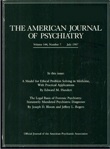This is a comprehensive, eclectic clinical volume dealing with the treatment of children who have suffered severe traumata during childhood. Its stated aim is to formulate specific types of therapy (actually therapeutic approaches) for various types of abuse and neglect. It purports to be an empirical study of preadolescent therapy.
The range of this volume is extensive. It moves from definitions of maltreatment to theories of emotional development (relying heavily on Bowlby's attachment theory), to the impact of trauma, and finally to detailed discussions of the treatment relationship, including the therapist's personal qualifications. The authors cross many boundaries, including the application of psychoanalytically based insights about psychopathology, cognitive and behavioral approaches, and even conditioning as both a causative factor and a therapeutic technique.
The authors have written what is essentially a handbook. At the beginning, they discuss and quote innumerable empirical studies about maltreatment, and the following clinical sections include assessment, goals of treatment, working with parents, and specific interactions with children, the latter being somewhat “how-to” in quality.
The authors are to be commended for their thorough scholarship. They have reviewed countless books and articles that may offer considerable help for future investigators, but many of these studies have limited value for clinicians. They deal with fairly large samples, but often their conclusions seem simplistic, especially when so much time, energy, and money have been involved. For example, one such study concluded, “Maltreated children as young as 2 years were more angry, non-compliant and frustrated . . . than were control children” (p. 20). Hardly a surprising conclusion. Poincaré, the famous French mathematician, once said that if you want to know the age of a ship's captain, it is better to ask him rather than count the planks on the deck. This may involve some risk, and in some instances be inaccurate, but it is less complicated and more economical than and, perhaps, just as useful as gathering statistics.
In the foreword, Dietrich states that psychological theories move in a cyclical fashion from simple to complex and then back to simple. He considers the present emphasis on genetic factors and chemical imbalance as simplistic reduction. This book represents, to him, a movement back to complexity.
I believe this book is a valuable contribution because it places so much emphasis on the relational aspects of treatment rather than on therapies based on drugs with little or no focus on determining what is emotionally happening to patients. Much therapy today is glued to DSM-IV clusters of symptoms and their elimination by chemical regulation. Psychiatry has, indeed, lost its mind as the intrapsychic focus is completely submerged.
Disagreeing with the foreword, I do not believe this book is particularly complex either in theory or practice. It is another volume of the genre of handbooks that explicitly instruct the reader. It will satisfy the needs of novices who are seeking something solid to organize themselves around, and it will bring certain items to the fore for more experienced practitioners that they may not have thought of. It lacks depth but not compassion.
To some extent, the authors reflect current trends in the behavioral sciences, but they maintain a humanistic interest in their patients, viewing them as disturbed individuals who have reacted to trauma with despair, characterized by dissociative mechanisms and the loss of the capacity to play. As clinicians, they relate to their patients' developmental defects, giving of themselves rather than relying solely on external adjuncts. That is why working with disturbed patients is both so difficult and so rewarding.

